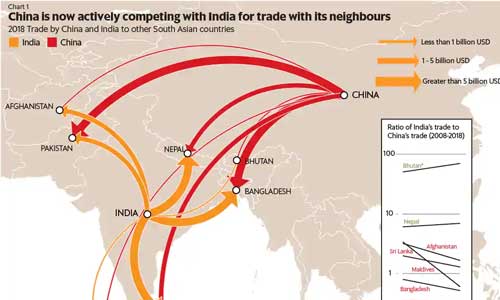China has experienced a remarkable rise in the international political and economic scenario after the international financial crisis of 2008. Today China is the second largest economy in the world and has experienced considerable rise within only a few decades. World Bank data show that its Gross Domestic Product (GDP) in 1990 was only $366.86 billion, while now it stands around $14.34 trillion (2019 estimates), with an average growth rate of around 9 percent in three decades. China is the largest trading nation, with exports of around $2.5 trillion in 2019, which shows an increase of 9.9 percent since 2015. It is also the largest producer and consumer of energy. The 2017 data reveal that China produced an estimated 112.018 quadrillion Btu of energy, whereas it consumed a staggering 139.435 quadrillion Btu. Data also show that the country has the world’s largest foreign exchange reserves – around $3.105 trillion – as per October 2019 estimates.
There is a bulk of such data that show that China is leading the world in many economic indicators, and is on the way to becoming the world’s largest economy within half a decade or so. Most importantly, data from China shows that the country has made remarkable achievements as far as reducing poverty is concerned. As per the World Bank data, since 1978, when the country opened its economy, it has lifted more that 850 million people out of poverty, and it is also on the way to eradicate extreme poverty till the end of 2020.
One of the reasons of rise in China’s economy is the long-term strategies adopted by its leadership. These long-term strategies clearly show that China is yet to achieve many milestones before it can reach to its dream of ‘making China great again’. However, the positive aspect of this grand strategy is that it plans to achieve it through economic grandeur, not a military one. China’s Belt and Road Initiative (BRI) is the most significant in this regard. The initiative is a multi-billion-dollar program that includes 71 countries and various infra-structure and development projects to connect Asian, Middle Eastern, European and African countries and their seas.
The land-based initiative of BRI is called Silk Road Economic Belt, and has six development corridors: New Eurasian Land Bridge Economic Corridor (NELBEC), China - Mongolia - Russia Economic Corridor (CMREC), China - Central Asia - West Asia Economic Corridor (CCWAEC), China - Indochina Peninsula Economic Corridor (CICPEC), Bangladesh - China - India - Myanmar Economic Corridor (BCIMEC), and China - Pakistan Economic Corridor (CPEC). However, the two initiatives, CCWAEC and CPEC are of prime importance as far as Afghanistan is concerned.
For Afghanistan, these initiatives can be game-changers, provided that they are involved in them. Recently, Afghanistan was allowed to use Pakistan’s Gwardar Port (the backbone of CPEC) for transit trade as Afghanistan itself is a landlocked country and does not have access to any sea. However, China has been investing in Afghanistan very cautiously; particularly, because of the prevailing insecurity and instability. Therefore, there is still a lot of work to be done before Afghanistan is made a part of BRI through the CPEC or the Central Asian Economic Corridor (CAEC).
Though Afghanistan’s instable political and social circumstances have limited its role, the country possesses a key strategic worth. It is a link between the Central Asia and South Asia and also significant in joining the eastern parts of Central Asia and China to the Middle East. Afghanistan has a short border (around 46 miles) with China at the Wakhan Corridor. Though most part of the border remain inaccessible because of Pamir mountains and freezing weather, a small section of it through the Wakhjir Pass is noteworthy, as the pass was a part of China’s Silk Route in the Middle Ages. The border is also significant for China, as it considers it a probable security risk because of the possible movement of terrorists that can join Uighur separatists in Xinjiang province. Presence of the United States’ forces in Afghanistan further complicates the situation along the border.
Despite reservations of insecurity and terrorism, Afghanistan can offer advantages to China as it looks to dominate the economic landscape of Asia. In addition to its strategic advantage mentioned above, Afghanistan is a land abundant in untapped mineral resources. Estimates by the United States show that the country may have mineral resources worth of trillion of dollars. These mineral resources include coal, copper, gold, iron, cobalt and lithium. As China would require bulks of resources in pursuing its grand strategy, these mineral resources can be significant for it. In particular, China would want to excavate the lithium resources in Afghanistan that can help in making batteries used in cellphones, and electric vehicles among other things. Both cellphones and electric vehicles form a significant part of future technology that many developed countries are striving to acquire. The electric vehicles can also help China in reducing its use of petroleum products that are causing environmental degradation in the country, and raising many eyebrows.
Thus, Afghanistan can benefit from being in the neighborhood of the rising China; particularly, after the withdrawal of the US forces from the country. However, it is imperative that the relations between the two countries remain dominated by the economic initiatives, not military considerations, which can complicate their relations and influence the grand Chinese strategy in the region.
Home » Opinion » Role of Afghanistan in the Neighborhood of Rising China
Role of Afghanistan in the Neighborhood of Rising China
| Sajjad Aasim

